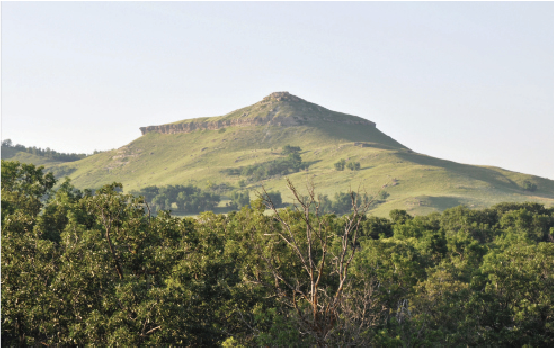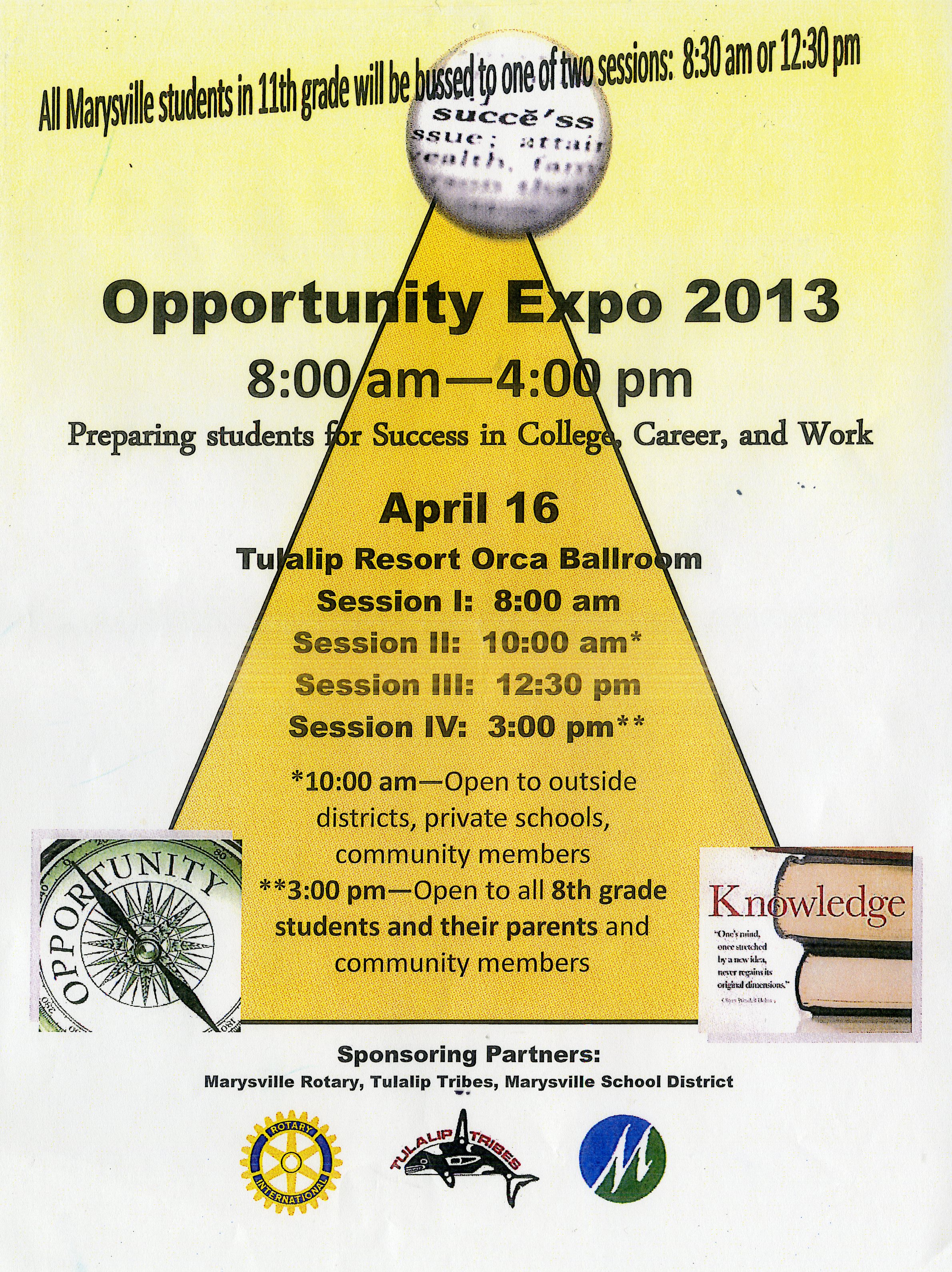The Tulalip Hibulb Cultural Center offers free, fun and educational events every month.
Author: Kim Kalliber
Opportunity Expo 2013 at Tulalip, April 16
Grants to Help Farms & Ranches Build Resilience to Drought
- South Dakota State University: Received $713,000 to establish four grazing management demonstrations on South Dakota and Nebraska ranches. Producers can observe and demonstrate the impacts of innovative grazing management practices on their land’s ability to recover from the 2012 and future droughts through the use of rainout shelters.
- Texas AgriLife Research: Received $233,000 to develop guidelines for managing irrigation under drought conditions and computer programs for linking weather stations with irrigation scheduling.
- University of Florida Board of Trustees: Received $442,000 to address adaptation to drought by demonstrating and evaluating innovative approaches for improving irrigation water use efficiency of agricultural crops under drought conditions.
- Colorado State University: Received $883, 000 to demonstrate synergistic soil, crop and water management practices that adapt irrigated cropping systems in the central Great Plains to drought and lead to efficient use of water. An existing model will be modified to allow farmers to calculate water savings from different conservation practices.
- Intertribal Buffalo Council: Received $640,000 to evaluate how traditional/historical practices aided tribes in dealing with drought, developing a best practices database, and using that information for training and demonstration projects. This grant will support 57 tribes in 19 states (Alaska, Arizona, California, Colorado, Idaho, Iowa, Kansas, Minnesota, Montana, Nebraska, New Mexico, North Dakota, Oklahoma, Oregon, South Dakota, Utah, Washington, Wisconsin and Wyoming.)
Tribal college fundraiser features real Coast Salish art
This year’s TL’aneq’ benefit dinner includes a live fashion show by international designer Dorothy Grant

On April 12, Northwest Indian College (NWIC) will host its 5th Annual TL’aneq’: Gathering for a Celebration benefit dinner and Native cultural arts and experiences auction from 5 p.m. to 9 p.m. at the Swinomish Casino & Lodge. The event is the college’s biggest fundraising event of the year and – this year – will also celebrate NWIC’s 30th anniversary.

Important Cultural, Religious and Historical Resources Threatened by Drilling
By Tanya Lee, Indian Country Today Media Network

Killdeer Mountain, home of the Singing Butte, looms on the edge of the North Dakota Badlands. (Courtesy Dakota Goodhouse/TheFirstScout.blogspot.com)
The Hess Corporation’s development of oil resources on Taĥċa Wakutėpi (Killdeer Mountain) on the edge of the North Dakota badlands threatens to destroy the integrity of a site sacred to tribes and important to historians, wildlife biologists, archaeologists and local landowners.
In a June 2010 report on the preservation of North Dakota battlefields, the National Park Service wrote, “Each of North Dakota’s battlefields remains a good candidate for comprehensive preservation, but Killdeer Mountain is most at-risk. While exploratory oil well drilling has had little effect on the battlefield’s condition so far, industrial scale extraction of the sub-surface resources at Killdeer Mountain could destroy the landscape and associated view-sheds in the near future.”
Killdeer Mountain was the site of an attack by U.S. Army Brigadier General Alfred Sully against a traditional summer gathering of American Indians for trading, socializing and ceremonies. On July 28 and 29, 1864, the general’s troops killed an estimated 150 Dakota and Lakota warriors and executed uncounted women and children. They destroyed as many as 1,800 lodges, 200 tons of buffalo meat and dried berries, clothes and household utensils, tipi poles, travois, and piles of tanned hides and slaughtered horses and perhaps 3,000 dogs. It was the final significant battle in the Dakota-U.S. War of 1862, but its deliberate brutality led to other conflicts. Among the survivors of the Battle of Killdeer Mountain were Sitting Bull and his lieutenant, Gall, who would fight again at the Battle of Little Big Horn in 1876.
The mountain was a sacred site long before the battle. Dakota Goodhouse, an enrolled member of the Standing Rock Sioux Tribe, says, “Killdeer Mountain is a place people still go to pray, [and there are] still people at Fort Berthold who visit the site for vision quests.”
Gerard Baker, an enrolled member of the Three Affiliated Tribes and a former National Park Service superintendant, is 59. As a child, he learned the ceremonial importance of Taĥċa Wakutėpi from his father, who learned it from tribal elders. “He told us the stories of Singing Butte, where Earth-naming ceremonies once took place. Many of the ceremonies are lost because of time, but they are still extremely important. Medicine Hole is associated with lost ceremonies. Many were lost during the smallpox epidemic of 1837.” Baker explains that unless a ceremony’s owner sells or gives away the ceremony before he dies, it can no longer be performed. So many Indians died so quickly during the smallpox epidemic that they did not have time to ensure the survival of their ceremonies.

But the spirits still live on Singing Butte. “The spirits live in different areas throughout the Dakotas in various buttes from Canada to the South Dakota line. The Hidatsa consider that their ancestral territory,” says Baker. Other lifeways that once took place on Killdeer Mountain included burials, fasting, trapping to get eagle feathers, deer-hunting and dressing.
A fundamental problem—and one of the challenges in opposing oil drilling on the mountain—says Baker, is that “not enough people know about the ceremonies. Even though people know the site is sacred, not so many know about the ceremonies.” He has a very pragmatic approach to dealing with Hess’s current oil drilling proposals. “I wish we could say ‘No drilling,’ but that’s not going to happen. They’re going to get that oil one way or the other.… We could hold up protest signs, but I think education would work better,” says Goodhouse. “I feel the issue is people don’t care because they don’t know” about Killdeer Mountain’s cultural or historical significance. “In an ideal world, there would be no wells near that area, but I have to be a realist. My suggestion is to drill laterally” for four miles, instead of the two miles of lateral drilling Hess is planning.
Opponents have won two concessions. “They have agreed that if they come across artifacts they will cease operations. But I know from experience that road companies do not stop development to save what’s there. They call in salvage archaeologists to survey,” says Goodhouse.
Richard Rothaus, president of Trefoil Cultural and Environmental, an archaeological consulting firm, had been planning to look at the Killdeer battlefield in 2014 or 2015, but when he heard about the imminent oil drilling there, he got permission to do a quick surface survey. He found three sites, two of them major. “This is an area that could have good, important information about the battle. It would be a shame to see it torn up without some work.”
Rothaus says he would need one excavation season, roughly one summer, to do 80 percent of the archaeological work that needs to be done at the battlefield. He has applied for funding for the work to the National Park Service American Battlefield Protection Program and will know in July whether the money will come through.
According to Rothaus, “Oil development is growing so fast out there that no one can keep track of it. People didn’t know this was being leased,” so they couldn’t do the archaeological work earlier. “Hess says it avoided the battlefield, but is 2.5 miles away from the historical marker for the battlefield, not three miles away from the battlefield.” The marker, he says, occupies just a couple of square feet of the vast battlefield. The wells Hess proposes are within the battlefield area.
The current situation on Killdeer Mountain, says Rothaus, came about through “a series of fairly innocent mistakes. I’ve almost never encountered anyone who doesn’t care about this history, but the right people are not at the table.”
Anne Marguerite Coyle, assistant professor of biology at Jamestown College in Jamestown, North Dakota, who spent three years studying golden eagles on Killdeer Mountain, concurs with Rothaus. “People don’t know when a plot of land might come up for lease.” The North Dakota Industrial Commission, she says, has no obligation to call other state agencies when they are planning to sell oil and gas leases.
Hess has agreed to a second concession, says Goodhouse. “The community did not want wells to be drilled during the school year because of the increased traffic, so they agreed to drill them in July.” But this concession brings its own problems. “The time they are going to put in the wells conflicts

with religious pilgrimages to area. If someone went to pray up there this summer, drilling would have an adverse effect, based on the impacts I saw of drilling at Bear Butte. There the development is five to 10 miles away from the sacred site. The dirt roads there were expanded to accommodate additional traffic. The traffic is heavy, loud and constant—not conducive to a vision quest.”
Goodhouse says a January meeting between the Mineral Resources Department and those with concerns about the drilling was “very civil, very cordial,” but whether education and goodwill can lead to other compromises is doubtful. Hess responded to a request to ICTMN’s request for an interview via e-mail: “Throughout the regulatory process, members of the community have had an opportunity to raise their concerns with the North Dakota Industrial Commission. We believe that the commission remains the best forum for concerns to be raised and addressed.”
Loren Jepson, a landowner on Killdeer Mountain, cattle rancher and former Hess employee, did raise the issue with the commission when he filed a petition in February asking the commission to suspend its order to allow the drilling and to rehear the case. The commission denied Jepson’s petition on February 20. One argument he made—in keeping with his intent to slow down the process in order to allow more time for study and compromise—was that the commission “failed to consider the best alternative of drilling the requested wells,” referring to the concept that the wells could be started further away from the battlefield. The commission found: “What Jepson has characterized as the failure to consider ‘the best alternative’ does not constitute grounds for rehearing or reconsideration.” In order to reopen the case, says Alison Ritter, spokeswoman for the commission’s Division of Mineral Resources, new information would have to be brought forward. “The commission carefully weighed the evidence,” she says, and the case has already been reopened once, last fall, which does not happen often.
Hess began preliminary work on the site one-quarter mile from Jepson’s house on February 21. He says an archaeologist is on site, but since the work moves so quickly and so much is destroyed in the process, it was unlikely anything would be found, an assessment Rothaus confirms. “Monitoring is just the last safeguard, not where you would want to start an archaeological investigation.”
Ritter explains that Jepson has run through his options at the executive level of the North Dakota state government and his next move would be to file an appeal in district court. Jepson says he does not know whether he will appeal. His attorney has told him that he would need $20,000 just to begin the process.
“I’m 60 years old,” Jepson says. “There are 30 [oil] wells here now and there will be 90 before the end of summer. I will never see the end of this. A way of life is gone, and it won’t come back.”
Read more at http://indiancountrytodaymedianetwork.com/2013/04/08/important-cultural-religious-and-historical-resources-threatened-drilling-148622
Slide pushes Amtrak train off tracks in Everett
No injuries reported when Empire Builder derails in Everett
By Sharon Salyer, The Herald

Burlington Northern Santa Fe and Amtrak officials examine the last two coaches of the Chicago to Seattle Empire Builder that derailed just north of Howarth Park in Everett on Sunday morning. There were no injuries in the derailment and passengers from the derailed cars were moved to the front cars as the train continued to Seattle with the two derailed cars being left behind.
An Amtrak train traveling from Chicago to Seattle was hit by a mudslide near Howarth Park in Everett on Sunday morning, derailing the last three passengers cars, which tilted but remained upright.
No injuries were reported among the 86 passengers and 11 crew members, an Amtrak spokesman said.
Three rail cars remained blocking the tracks. The rest of the train was decoupled and continued on to Mukilteo to discharge passengers, Rick Robinson, fire marshal for the Everett Fire Department. Passengers were bused to Seattle.
Sound Transit announced Sunday on its website that Sounder service was cancelled for Monday and Tuesday. Amtrak also said its train service would be affected between Vancouver, B.C., and Portland, Ore., until after Tuesday, with passengers being taken by bus.
After earlier slides this winter passenger trains have been barred from the tracks for 48 hours after a slide.
The tracks between Seattle and Everett have been plagued with slides in recent months.
“We’ve had more than 200 slides this past winter and spring,” said Gus Melonas, spokesman for Burlington Northern Santa Fe, which owns the tracks.
The landslide occurred about 8:30 a.m., affecting two coach cars and the train’s dining car.
The slide was triggered about 100 feet up a 200-foot cliff, depositing a patch of dirt and debris 15 feet deep and 30 feet wide along the tracks a quarter-mile north of Howarth Park, Melonas said.
The force of the slide was enough to “tip the rails over, not the cars, just the rails,” Robinson said.
Two ladder trucks, three engine trucks and two medic units were dispatched to the scene.
About one-quarter mile of track needed to be realigned with the repairs expected to be completed by Monday morning, Melonas said. No estimate of the cost to repair the track was immediately available.
The slide affected the inner line of two main rail lines. However, freight train traffic was not disrupted and two freight trains moved through the area Sunday afternoon, Melonas said.
The Associated Press contributed to this report.
To honor Chantel’s memory
No greater sin than inflicting misery and pain on a child.
The darkness, when God seems silent, fell on Chantel Craig, a 19-month Tulalip girl and her 3-year-old sister. Chantel died, her sister survived. Last October, they sat strapped in their car seats like victims of a plane crash, abandoned by their drug-addled mother, festering in a derelict vehicle for days.
Agony has a face. Chantel was “severely malnourished” according to the postmortem. She was blanketed by lice, urine, bed bugs, feces and “a bleeding rash.” Her mom has been charged with murder.
Chantel’s death, according to the Snohomish County Medical Examiner, was neglect. And “neglect” is the operative word. Chantel and her sister fell away from social workers, social workers freighted by heavy case loads but laboring to do the right thing. They slipped through the latticework of state and tribal oversight.
Now the state and the Tulalip Tribes need to work in common cause, to address communication misfires, and to embrace solutions with teeth.
The Herald’s Diana Hefley served as an official observer of the Child Fatality Review, the investigation and report on Chantel’s death, conducted by the Department of Social and Health Services’ Children Administration. Her reporting crystallized the tragedy.
“They were asked to inspect the net,” Hefley writes. “Maybe it can be woven tighter so another little girl won’t fall through, dying before she learns to twirl on tiptoes or color inside the lines or dream of being a princess or a firefighter.”
The fatality review produced four findings and three recommendations that demand action. Priority one is to delineate specific social worker responsibilities in the memorandum of understanding (MOU) between the Tulalip Tribes and DSHS Children’s Administration. Tribal and state employees navigate the MOU’s vague language like a United Nations compact. Elastic wording doesn’t help case workers who need to know their specific role.
The MOU is authorized by the Indian Child Welfare Act of 1978 to oversee the custody and care of Indian children. The act is a window on a tainted legacy, when the United States regularly removed Indian children from their homes and traditional culture.
The review’s second and third recommendations are manageable. Retaining and hiring more Child Protective Services workers is doable with additional funding from the Legislature. CPS workers are committed and professional. In Chantel’s case, they didn’t have the resources for critical follow-through, however.
As the second finding highlights, the committee was concerned about the “lack of documented attempts to locate the family” for six months, from December 2011 to May 2012.
Active cases require a monthly review by a supervisor. There is no documentation that any reviews occurred between May 7, 2012, and Oct. 8 the same year. Are revolving-door supervisors to blame? The Children’s Administration might consider an administrative bucket for overworked CPS workers to send follow-ups that can’t be met (with no penalty for acknowledging they simply don’t have time.) Another CPS worker would be assigned to help. The Catch-22 is this approach might disrupt continuity, a concern the committee underlined when supervisory coverage changes.
Bureaucracies are soulless, social workers are not. To make the Chantel Craig tragedy right presupposes that human nature, including the menace of drugs and child abuse, is tractable. It isn’t. So we begin changing what we can, starting with the fatality review’s recommendations. Chantel deserves as much.
Eric Carle shares works from his own collection
By Theresa Goffredo, The Herald

“The Very Hungry Caterpillar,”1969, 1987 by Eric Carle
Eric Carle’s picture books have been a fixture in bookstores and kids’ bedrooms for generations.
His “The Very Hungry Caterpillar” and “Brown Bear, Brown Bear” are must-reads for most preschoolers.
But there’s been a very busy, a very private side of Carle that the public hasn’t seen.
If you or your kids are Eric Carle fans you might want to head down to the Tacoma Art Museum when the artist unveils for the first time out of his hometown in Massachusetts his private collection of art in an exhibit called “Beyond Books: The Independent Art of Eric Carle.”
The exhibit kicks off with a chance to meet the author and illustrator during a book signing at 3 p.m. Sunday at the Tacoma Art Museum, 1701 Pacific Ave., Tacoma.
If you don’t meet the artist Sunday, you’ll still have plenty of time to see his new exhibit, which is on view through July 7.
This exhibit unveils what Carle calls his “art/art” and consists of paintings, personal sketches, posters, linoleum cuts, abstract collages and caricature notes — funny and irreverent hand-drawn notes written to friends and colleagues, according to a press release.
Among the collection items are Carle’s unique 3-D pieces including metal sculptures and painted glass creations, as well as costume designs for opera.
But this exhibit will include both the private and public works of Carle. In fact, one of the museum’s galleries will highlight Carle’s picture book art and include images from “The Very Hungry Caterpillar” and “The Artist Who Painted a Blue Horse.”
The gallery will include a video about Carle’s work and, for the kids, interactive art activities.
A few other special events during the run of the exhibit include a walking tour of the exhibit with museum director Stephanie A. Stebich. That is at 10:30 a.m. Wednesday.
Museum admission is $10 for adults, $8 for students, military and seniors, $25 for a family, and free for children 5 and younger.
There will also be a session where kids and parents can try to create Carle’s artwork themselves. “Books and Beyond: The Art of Collage,” will be from 10 a.m. to 1 p.m. June 29 where guests can create a painting collage. The cost for this session is $35 ($25 for museum members), and covers one adult with or without a child. Cost of admission for each additional child is $10.
Theresa Goffredo: 425-339-3424; tgoffredo@heraldnet.com.
As long as you’re there
When your kids have had enough of the Eric Carle exhibit, take them to the Tacoma Art Museum’s free open art studio so they can explore their inner artist. Kids can either follow one of the studio’s four art stations or use the professional art supplies to make their own creations.
The Museum of Glass, the Washington State History Museum and Lemay — America’s Car Museum are all nearby. Go to tacomaartmuseum.org, museumofglass.org and lemaymuseum.org for more information and directions.
Hungry?
Here are some kid-friendly options not far from the museum:
•The Old Spaghetti Factory, 1735 Jefferson Ave. This restaurant serves dependable pasta dishes.
The Rock Wood Fired-Pizza & Spirits, 1920 Jefferson Ave. Casual dining with a variety of pizzas.
Frisco Freeze, 1201 Division Ave. This local landmark ’50s-era drive-in serves old-style burgers and fries.
The Fish House Cafe, 1814 S. Martin Luther King Jr. Way. Inexpensive local favorite for Southern-style fish and chips, hush puppies, and mac and cheese using fresh local fare.
Staying over?
Family lodging options include the Hotel Murano, 1320 Broadway Plaza, featured on the Conde Nast Traveler’s Readers Choice list. This is a boutique hotel offering luxury accommodations and lots of, you guessed it, art. Glass art in particular, including Chihuly glass art.
World Health Day: What Steps Will You Take to Stay Healthy and Cancer-Free?

Source: Indian Country Today Media Network
April 7, 2013 is World Health Day. As part of the movement to promote healthy living, what steps will you take to stay healthy and cancer-free?
The American Cancer Society has five easy suggestions that will help keep you healthier and reduce your risk of cancer at the same time.
Get off the couch and get on the treadmill. Or on the stair stepper. Or on the elliptical. Whatever the case, get active! Now that Spring is finally here, you don’t have an excuse. Grab a loved one and go for a nice evening walk outside. The American Cancer Society recommends a minimum of 30 minutes of exercise daily for adults, so get moving!

Avoid drinking in excess. If you drink, limit alcohol to one drink per day for women and two drinks per day for men. The American Cancer Society has found that drinking damages body tissue and increases the risk of cancer. Is the extra drink really worth the risk?
Watch your waistband. Arlene St. John Black Bird, program director for the Breast & Cervical Cancer Early Detection Program (BCCEDP) at Cheyenne River Health Center in Eagle Butte, South Dakota, offers some dietary advice: “Research shows that poor diet is strongly linked to cancer. To stay healthy, limit red meat and avoid processed meat. Instead, try lean proteins like chicken or turkey. Making small changes to your diet can actually make a big difference.”
Get regular cancer screenings. If you have a family history of cancer, you should talk to your doctor about getting screened at an early age. Statistics show that early detection saves lives.
Be tobacco free. Tobacco use accounts for at least 30 percent of all cancer deaths and 87 percent of lung cancer deaths. By smoking, you’re not only putting yourself at risk—you’re also jeopardizing your loved ones. Each year, about 3,400 non-smoking adults die of lung cancer as a result of breathing secondhand smoke. Quit today and keep yourself and your loved ones cancer-free.
Did you know that 2/3 of all cancers are preventable? That means following the American Cancer Society’s guidelines will reduce your risk of cancer and, potentially, save your life.
With statistics like that, it seems like a no-brainer: This World Health Day, commit to healthy living.
For more healthy living suggestions, contact the American Cancer Society at 1.800.227.2345 or www.cancer.org.
Read more at http://indiancountrytodaymedianetwork.com/2013/04/07/world-health-day-what-steps-will-you-take-stay-healthy-and-cancer-free-148649
New building for EvCC nursing students
By Sharon Salyer, The Herald
Nursing students at Everett Community College better be on their toes in their new Liberty Hall digs, a $37.5 million building that opened Monday.
They get training on how to respond to patients having heart attacks, strokes and delivering a baby.
The simulation mannequins the nursing students practice on, a man, pregnant woman and infant, cost a total of about $155,000.
The mannequins have features so sophisticated that they can register how much oxygen is being administered, detect when the wrong drug or wrong dose of a drug has been given and simulate the health problems it would trigger.
“Until you solve it, they get worse,” said Gail McLean, a nursing instructor.
The practice sessions can be videotaped so that students can learn from the simulation drills or they can be provided as a “live feed” to other students.
“We like to run them through a scenario,” McLean said. “Sometimes they make mistakes or think of other ways to do things. We run them through that same exact scenario and they get to do it correctly. When they leave here they know how to do it right.”
The simulation lab is just one part of the 72,000-square-foot building where about 500 students take classes each day.
The three-story building also houses a phlebotomy lab, where students are trained to draw blood samples.
Lecture rooms with a document camera can project images of tiny pieces of equipment onto a nearby screen so that all students can clearly see what’s being discussed.
A forensics lab, part of the college’s criminal justice program, helps students learn to read fingerprints and gather other crime scene material.
The building will be the new home later this year for Providence Everett Healthcare Clinic, now located across the street at 1001 N. Broadway. The clinic is open to anyone but targets uninsured, low-income and Medicare patients.
Planning for the new building began about three years ago and its construction spanned 15 months, said Elliot Stern, interim dean for health sciences and public safety.
A public open house will be scheduled in June.
The new brick building, which borders North Broadway, replaces two buildings that opened on the campus in 1968, Index and Liberty, which later expanded to four buildings and was later named Index Hall.
Liberty Hall is named after a mountain in the Cascade Range near Three Fingers Mountain.
Sharon Salyer: 425-339-3486; salyer@heraldnet.com.
Past projects
In the past seven years, Everett Community College has completed almost $150 million in construction projects. They include:
•Liberty Hall: The $37.5 million, 72,000-square-foot building is home to the college’s nursing, medical assisting and phlebotomy programs and other health sciences training, plus the college’s criminal justice program. It also will be the new home of Providence Everett Healthcare Clinic, now located across Broadway. Opened Monday.
Corporate & Continuing Education Center: A $4 million renovation of the interior of the two-story structure, including an expansion to 12 classrooms, four technology classrooms, a conference room, student lounge and a meeting area for up to 100 people. The center provides professional development and career training for individuals and training for employers. Finished in December.
Henry M. Jackson Conference Center: A $3.3 million renovation that moved the college’s Enrollment Services and Cashiers Office to the Parks Student Union and remodeled the building for use as a conference and meeting space. Finished in May.
Parks Student Union, May 2011: A $5.3 million remodel and expansion that added 5,600 square feet, including a new cafe, remodeled the Russell Day Gallery and provided more study space for students. It was funded in part by student fees. Finished May 2011.
Fitness Center: The $19.5 million, 49,000-square-foot fitness center includes classrooms for physical education and health programs, a gym with retractable bleacher seating for 2,250, a cardio and free-weight training room, a climbing wall, running track, a multipurpose small gym and offices for faculty and staff. The center replaced the college’s 1958 gym. The building was funded in part through student fees and money from the sale of the college’s old gym to Providence Regional Medical Center Everett. Finished in January 2011.
Gray Wolf Hall: The 77,000-square-foot, $49 million building is home to classes in the humanities, social sciences and communications and the University Center of North Puget Sound, which offers more than 25 bachelor’s and master’s degree programs from eight colleges and universities. Opened in March 2009.
Whitehorse Hall: The 88,000-square-foot building is home to the college’s visual arts, physical sciences and journalism classes. The $27 million building was the first of four new buildings added to the Tower Street campus, which opened in 1958. Finished in January 2007.
Source: Everett Community College











